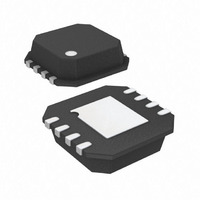SSM2211CPZ-REEL7 Analog Devices Inc, SSM2211CPZ-REEL7 Datasheet - Page 19

SSM2211CPZ-REEL7
Manufacturer Part Number
SSM2211CPZ-REEL7
Description
IC,Audio Amplifier,SINGLE,CMOS,LLCC,8PIN,PLASTIC
Manufacturer
Analog Devices Inc
Type
Class ABr
Datasheet
1.SSM2211SZ.pdf
(24 pages)
Specifications of SSM2211CPZ-REEL7
Output Type
1-Channel (Mono)
Max Output Power X Channels @ Load
1.5W x 1 @ 4 Ohm
Voltage - Supply
2.7 V ~ 5.5 V
Features
Differential Inputs, Shutdown
Mounting Type
Surface Mount
Package / Case
8-LFCSP
Operational Class
Class-AB
Audio Amplifier Output Configuration
1-Channel Mono
Audio Amplifier Function
Speaker
Total Harmonic Distortion
0.2%%
Single Supply Voltage (typ)
3/5V
Dual Supply Voltage (typ)
Not RequiredV
Supply Current (max)
20@5V@-40C TO 85CmA
Power Supply Requirement
Single
Unity Gain Bandwidth Product (typ)
4MHz
Rail/rail I/o Type
Rail to Rail Input
Power Supply Rejection Ratio
66dB
Single Supply Voltage (min)
2.7V
Single Supply Voltage (max)
5.5V
Dual Supply Voltage (min)
Not RequiredV
Dual Supply Voltage (max)
Not RequiredV
Operating Temp Range
-40C to 85C
Operating Temperature Classification
Industrial
Mounting
Surface Mount
Pin Count
8
Package Type
LFCSP EP
Lead Free Status / RoHS Status
Lead free / RoHS Compliant
Lead Free Status / RoHS Status
Lead free / RoHS Compliant
Other names
SSM2211CPZ-REEL7
Available stocks
Company
Part Number
Manufacturer
Quantity
Price
Company:
Part Number:
SSM2211CPZ-REEL7
Manufacturer:
ADI
Quantity:
7 500
Company:
Part Number:
SSM2211CPZ-REEL7
Manufacturer:
AD
Quantity:
1 200
Part Number:
SSM2211CPZ-REEL7
Manufacturer:
ADI/亚德诺
Quantity:
20 000
voltage reference. The extra supply voltage also allows the
SSM2211 to reproduce peaks in excess of 1 W without clipping
the signal. With V
the maximum power dissipation for the SSM2211 is 633 mW.
From the power derating curve in Figure 31, the ambient
temperature must be less than 50°C for the SOIC and 121°C for
the LFCSP.
The required gain of the amplifier can be determined from
Equation 17 as
From Equation 1
or R
R
The final design step is to select the input capacitor. When
adding an input capacitor, C
corner frequency needs to be far enough away for the design to
meet the bandwidth criteria. For a first-order filter to achieve a
pass-band response within 0.25 dB, the corner frequency must
be at least 4.14× away from the pass-band frequency. Therefore,
(4.14 × f
input capacitor can be found.
Therefore, C
The gain bandwidth product for each internal amplifier in the
SSM2211 is 4 MHz. Because 4 MHz is much greater than 4.14 ×
20 kHz, the design meets the upper frequency bandwidth criteria.
The SSM2211 can also be configured for higher differential
gains without running into bandwidth limitations. Equation 16
shows an appropriate value for C
noise.
Selecting C
minimizes start-up popping noise.
To summarize the final design
V
R1 = 20 kΩ
R
C
C
T
A, MAX
I
F
C
B
DD
= 20 kΩ and R2 = 28 kΩ.
= 28 kΩ
= 2.2 μF
= 2.2 μF
F
= 5 V
C
C
A
R
= 1.4 × R
R
C
V
F
B
= 85°C
I
HP
=
>
>
=
) < 20 Hz. Using Equation 2, the minimum size of an
B
(
A
π 2
C
2
2
to be 2.2 μF for a practical value of capacitor
V
V
> 1.65 μF. Using a 2.2 μF is a practical choice for C
.
P
2
I
L
IN,
. Because the desired input impedance is 20 kΩ,
×
μF
25
×
20
rms
DD
)(
R
kΩ
20
kΩ
= 5 V and R
L
1
kΩ
=
⎛
⎜ ⎜
⎝
2
20
)
4
8 .
.
=
C
14
Hz
, to create a high-pass filter, the
1
.
76
⎞
⎟ ⎟
⎠
B
L
= 8 Ω, Equation 9 shows that
to reduce start-up popping
μF
(17)
(18)
(19)
Rev. E | Page 19 of 24
C
.
SINGLE-ENDED APPLICATIONS
There are applications in which driving a speaker differentially
is not practical, for example, a pair of stereo speakers where the
negative terminal of both speakers is connected to ground.
Figure 48 shows how this can be accomplished.
It is not necessary to connect a dummy load to the unused
output to help stabilize the output. The 470 μF coupling capa-
citor creates a high-pass frequency cutoff of 42 Hz, as given in
Equation 4, which is acceptable for most computer speaker
applications. The overall gain for a single-ended output config-
uration is A
DRIVING TWO SPEAKERS SINGLE ENDEDLY
It is possible to drive two speakers single endedly with both
outputs of the SSM2211.
Each speaker is driven by a single-ended output. The trade-off
is that only 250 mW of sustained power can be put into each
speaker. In addition, a coupling capacitor must be connected in
series with each of the speakers to prevent large dc currents
from flowing through the 8 Ω speakers. These coupling
capacitors produce a high-pass filter with a corner frequency
given by Equation 4. For a speaker load of 8 Ω and a coupling
capacitor of 470 μF, this results in a −3 dB frequency of 42 Hz.
Because the power of a single-ended output is one-quarter that
of a BTL, both speakers together are still half as loud (−6 dB
SPL) as a single speaker driven with a BTL.
AUDIO
AUDIO
AUDIO
INPUT
INPUT
INPUT
Figure 49. SSM2211 Used as a Dual-Speaker Amplifier
0.47μF
0.47μF
V
1μF
= R
Figure 48. Single-Ended Output Application
20kΩ
10kΩ
10kΩ
0.1μF
0.1μF
0.1μF
F
/R
1
, which for this example is equal to 1.
4
4
3
3
4
3
–
+
–
–
+
+
SSM2211
SSM2211
SSM2211
2
2
2
20kΩ
10kΩ
10kΩ
6
6
6
5V
5V
5V
7
7
7
1
1
1
5
8
5
5
8
8
470μF
470μF
470μF
470μF
–
+
+
–
+
+
–
–
SSM2211
LEFT
SPEAKER
(8Ω)
RIGHT
SPEAKER
(8Ω)
250mW
250mW
SPEAKER
SPEAKER
(8Ω)
(8Ω)















